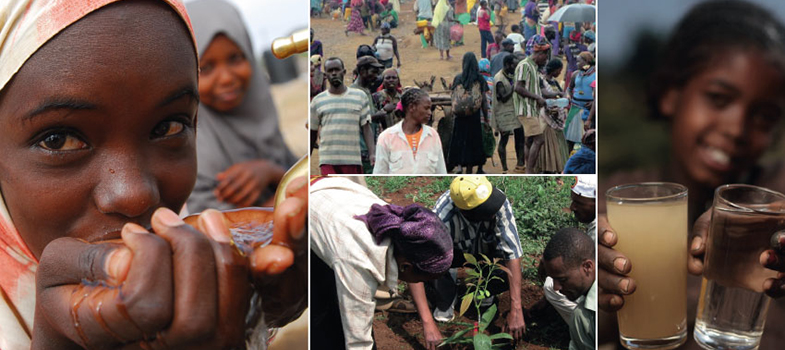Self-Assessment Questions (SAQs) for Study Session 12
Now that you have completed this study session, you can assess how well you have achieved its Learning Outcomes by answering these questions.
SAQ 12.1 (tests Learning Outcomes 12.1 and 12.2)
Imagine there is a local NGO working in the town you are assigned to that wants to develop a school WASH programme. While preparing the project documents, the delegates of the local NGO come to your office and ask you to support them. List the minimum requirements that you will advise them to include in the sanitation and hygiene part of their programme.
Answer
Your advice to the NGO needs to suggest that:
- Separate latrines for boys and girls should be provided that are located in a convenient place in the school compound, give privacy to users, are easy to clean and agreeable to use.
- The number of latrines should be calculated based on the number of students (one cubicle per 100 students) with a minimum of two cubicles for girls and two for boys, with urinals as well.
- Latrines should be designed and constructed to be appropriate for children of the age at the school; small children will need facilities they can reach and feel comfortable using.
- There should be appropriate latrine and handwashing facilities for students with disabilities.
- Handwashing facilities with soap should be provided very close to the latrines with separate facilities for boys and girls. The supply of water for handwashing must be maintained at all times.
- There should be appropriate provision of menstrual hygiene management facilities that ensure privacy for girls and allow them to dispose of or wash used menstrual pads hygienically.
SAQ 12.2 (tests Learning Outcome 12.2)
If the same NGO wanted to extend their schools programme to include improvements to solid waste management, what further advice would you offer?
Answer
To improve management of solid waste in schools you could advise that there should be:
- waste bins in all classrooms and teachers rooms, with separate bins for recyclable and non-recyclable waste
- a regular cleaning schedule to keep classrooms and all other parts of the school including latrines and the outside areas, clean and tidy
- efforts made to discourage students from dropping litter anywhere in the school and to take pride in a clean school environment
- a disposal pit in the grounds that is fenced off, if the school has to dispose of its own waste. Waste deposited in the pit should be covered immediately with soil.
SAQ 12.3 (tests Learning Outcomes 12.1 and 12.3)
In many towns in Ethiopia, primary collection of solid waste is done by micro- and small enterprises (MSEs). Health centres and other health institutions in the town are customers of the MSEs. Imagine you were organising some technical training for the MSE employees. Describe the major hazardous waste components of healthcare wastes that you would address during the training and identify appropriate disposal methods for each of them. In particular explain how anatomical waste should be disposed of.
Answer
Firstly, you should explain to the MSE employees that they should only collect the non-hazardous waste which should be in black bins. They should not collect waste in yellow or red bins unless authorised, because this contains hazardous material and should be kept separate. Hazardous waste needs proper management starting from generation to disposal.
However, they need to be made aware of the possible hazardous wastes and appropriate disposal methods as follows:
- Sharps (needles, syringes etc.) should be put immediately in a sharps box and then incinerated and/or burned in a sharps pit.
- Materials contaminated with blood or body fluids such as bandages and used gloves could be infectious so should be stored in a yellow bin and incinerated and/or buried.
- Anatomical waste including placentas, body parts, blood etc. is also infectious and should be stored in a red bin, or yellow bin if red is not available. These wastes should not be handled by the MSE employees but should be buried in a placenta pit. A placenta pit is a burial pit specifically for placentas and other anatomical waste. It should be at least 1 m deep and be surrounded by a fence with a lockable gate. Waste should be transported on a dedicated trolley or cart, deposited in the pit as soon as it is produced and covered immediately with soil.
You should also advise the MSE employees to wear gloves and other protective clothing when carrying out their duties.
SAQ 12.4 (tests Learning Outcome 12.4)
Briefly describe the main activities needed for planning improvements in sanitation and waste management in local institutions.
Answer
The following step-by-step actions are important when developing a plan for an improvement programme:
- Know the scope of activity by identifying the institutions to be included.
- Assess the existing sanitation and waste management situation and identify the main problems.
- Identify the possible partners that you can work with.
- Identify and prioritise activities taking account of available resources.
- Develop and implement the plan of action.
Summary of Study Session 12
